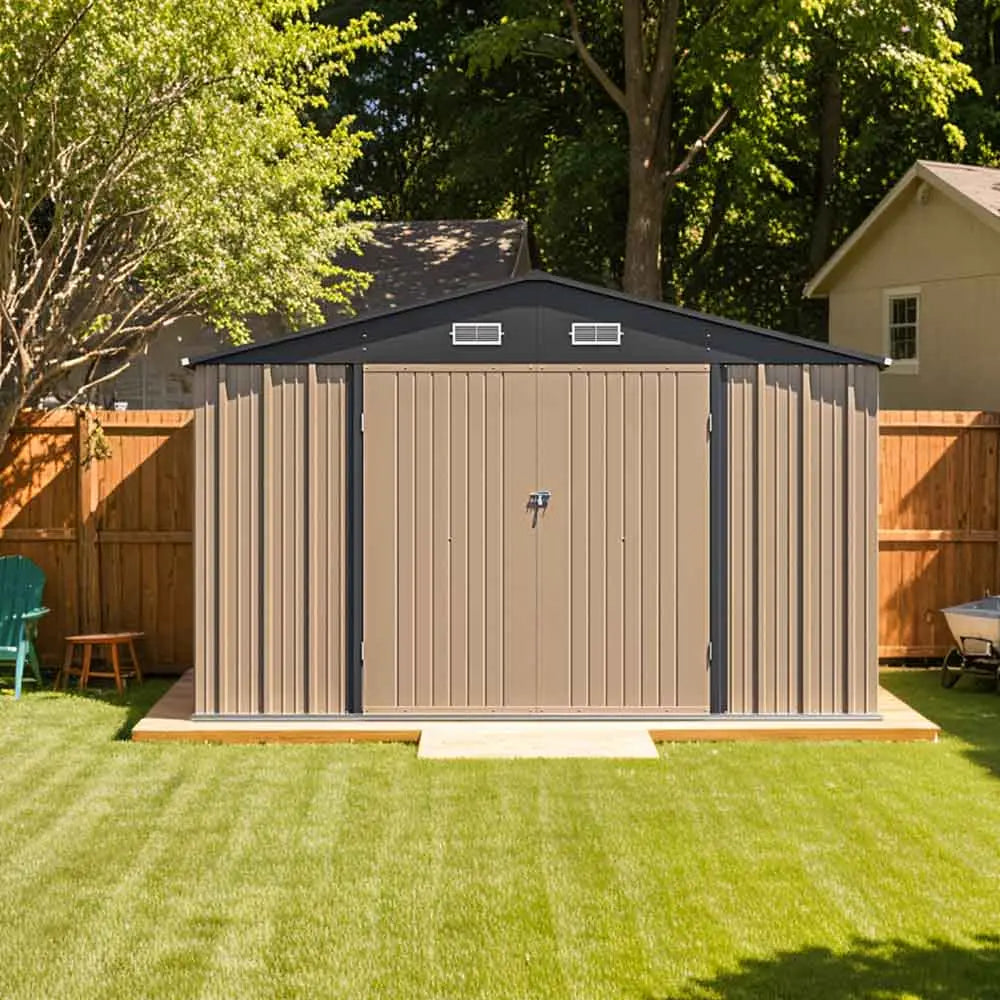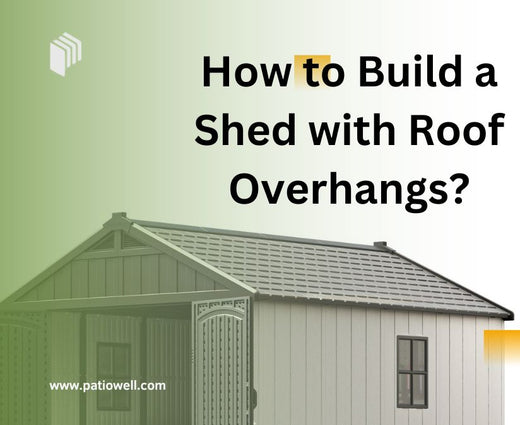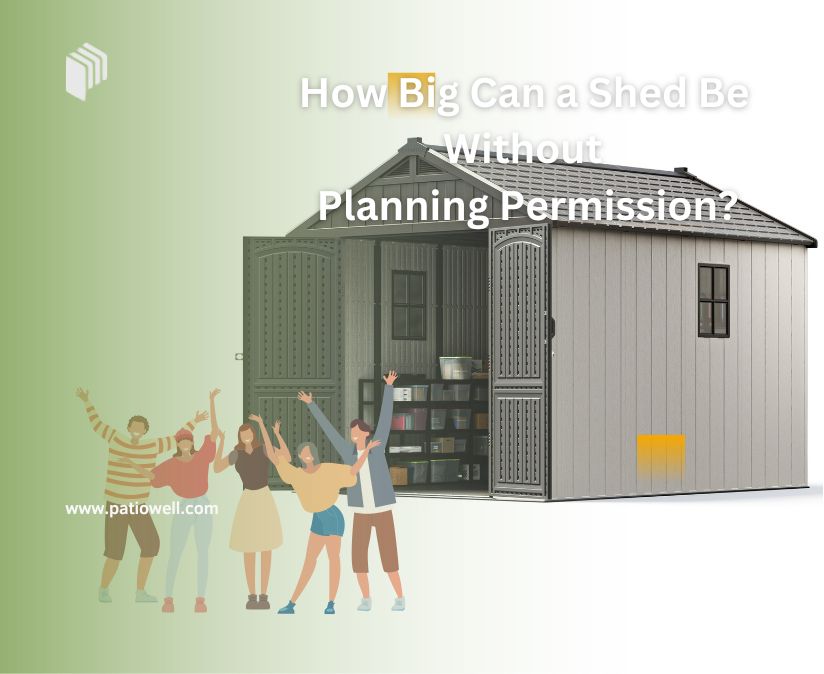Are you trying to find out how many materials for a 10x12 shed? Whether you build yourself or hire one, determining how many materials to use can be an inexact science. It can easily become overwhelming with details ranging from how many shingles, how much plywood and how much gravel you will have to use.
But don't sweat it, as this article will break it all down for you. We will take you through what exactly you'll need for each part of the shed to make sure that when it comes to installation, you have just the right material in hand.
Table of Contents:[hide]
How Many Bundles of Shingles for a 10x12 Shed?
When planning a 10x12 shed to a roof, one of the first questions you may have is how many bundles of shingles for a 10x12 shed are needed. Shingles are sold in bundles, with each bundle covering approximately 33 square feet of roof area. To find out how many bundles you will need, you will have to know the total square foot of your shed's roof.
Here's how to figure it out:
- Calculate the Roof Area: Multiply the length by the width of your roof. For a standard 10x12 shed, the total area would be 120 square feet.
- Adjust for Roof Slope: If your shed has a pitched roof, you'll need to factor in the slope. For a simple, single-pitched roof, add about 20-30% extra coverage. If it's a gable roof (two sloping sides), you'll need to calculate for both sides, doubling the total area.
So, for a standard 10x12 shed with a simple roof pitch, you'd need about 4 bundles of shingles. If the roof is steeper or has more complex angles, you might need five or more bundles. It's always a good idea to buy a little extra to account for mistakes or future repairs.
With the number of shingles sorted out for now, let's turn our attention to the other vital material: gravel.
How Much Gravel Do I Need for a 10x12 Shed?
Other important things to consider when building a 10x12 shed include the foundation, and how much gravel you will need for it. Gravel provides a solid, level base for your shed, improves drainage, and prevents the structure from sinking or shifting over time.
Here's how to figure it out:
- Determine the Depth: A typical gravel foundation for a shed is about 4-6 inches deep. For this calculation, let's go with 4 inches, which is a common choice.
- Calculate the Volume: Multiply the length, width, and depth of the gravel base. For a 10x12 shed with 4 inches of gravel, the formula looks like this:
- 10 feet x 12 feet = 120 square feet (area)
- 4 inches = 0.33 feet (since there are 12 inches in a foot, 4 inches is 1/3 of a foot)
- Volume of gravel = 120 sq. ft. x 0.33 feet = 39.6 cubic feet
- Convert to Cubic Yards: Gravel is usually sold by the cubic yard. Since there are 27 cubic feet in a cubic yard, divide 39.6 cubic feet by 27 to get about 1.5 cubic yards of gravel.
With that, a 10x12 shed would come out at 1.5 cubic yards for four inches of gravel. In case you need to go deeper, say 6 inches, you would then change your calculation by the intensity of that deepened layer.
Once the gravel foundation is laid, you can begin the next process or decision: that of calculating how much plywood floors will go on top of the shed area.
How Many Sheets of Plywood Do I Need for a 10x12 Shed Floor?
Plywood sheets come in the normal sizes of 4 feet by 8 feet, accounting for 32 square feet in one sheet. The procedure to figure out how many sheets one will need for the floor will be determined as follows:
- Calculate the Floor Area: For a 10x12 shed, the floor area is simply the length times the width:
- 10 feet x 12 feet = 120 square feet
- Determine the Number of Sheets: Since each plywood sheet covers 32 square feet, divide the total floor area by the area of one sheet:
- 120 square feet ÷ 32 square feet per sheet = 3.75 sheets
Since you can't buy a fraction of a sheet, you will need to round up. Therefore, your 10x12 shed would take 4 sheets of plywood for the floor.
Thicker plywood or adding extra layers in other areas for added strength may require more sheets than the calculated amount. It is normally good to get one or two sheets just in case some adjustments or fixes need to be made at any given time.
With the plywood sorted, you're off toward a strong, solid shed floor. Now let's give you some practical tips that will have you getting the most of your materials and effort well used.
Practical Tips from Experience
Building a shed is one heck of a project, yet it may have its tricky times. Here are some simple tips from experience that will help you get it right:
- Order Extra Materials: Even if you have done the math and worked out how much you need, it is always best to order a bit extra. You never know when you might need extra shingles, plywood, or gravel.
- Prepare the Site: Prepare the site to make sure the ground is clear, level, and firm. This will enable your gravel foundation to go down smoothly and your shed to have a solid base.
- Use Pressure-Treated Wood: Use pressure-treated wood for those parts of the shed that touch the ground. It's stronger and helps prevent rot and damage over time.
- Think About Insulation: If you will be using the shed in all seasons or storing things that are sensitive, consider adding insulation to keep things cooler in summer and warmer in winter.
- Take Your Time on the Roof: The roof is an extremely important aspect. Don't rush through the process of laying shingles in order to avoid leaks later on.
- Choose Good-Quality Materials: Spending a little extra on good materials will last longer and give your shed stronger shingles, plywood, and gravel.
- Check Local Building Rules: Check with the local building authorities if building a shed requires a permit or if there are any rules about it. This will save you from unnecessary trouble.
Follow these shed tips, and you can't go wrong in starting to build a great shed. Now, let's go forward and see how to decide on the best 10x12 shed for your purpose.
How to Choose the Best 10x12 Shed?
When selecting the best 10x12 shed for your needs, several factors should be considered, including material, installation ease, storage capacity, and cost-effectiveness. The 10x12 size is perfect for those looking for a practical solution that doesn’t overwhelm smaller backyards. This size typically provides ample storage—roughly equivalent to two parking spaces—while still being compact enough to fit into various spaces without requiring a building permit in many areas.
One key consideration when choosing a shed is the material. Metal sheds, like the 10x12 metal shed offered by PatioWell, are durable and low maintenance. This is a great choice for those who want a shed that can withstand different weather conditions without needing regular upkeep like wooden sheds.
Here’s why we recommend the Patiowell 10x12 Metal Shed Pro With an Optional Floor Base:
- Easy to Install: The shed is designed for quick and straightforward assembly, which is ideal for those looking to avoid complicated setups.
- Big Savings: The 10x12 metal shed offers a cost-effective solution for outdoor storage needs, providing durability and functionality without the high price tag of other materials.
- Organize the Space: With smart shelving and wall-mounted hooks, this shed helps you maximize its interior to keep your tools, equipment, and gardening supplies neatly organized.
- Great Storage Solution: Its spacious 10x12 size provides ample room for storing everything from lawn equipment to seasonal items, making it an excellent choice for homeowners who need efficient, organized outdoor storage.
Whether you’re looking for a storage solution to tidy up your garden or a simple tool shed, the PatioWell 10x12 metal shed meets all these needs while being an affordable, easy-to-install choice for your outdoor space.

- Spacious 10x12 ft Metal Storage Shed
- Durable Metal Construction.
- Ventilated for Airflow
- Secure & Lockable
- Versatile Aesthetic
Conclusion
So that's all you need to know about how many materials for a 10x12 shed. Prepare your complete list on the front that includes all the accessories and units such as shingles, gravels, or plywood before going to their stores.
Diana Mason
Hi there! I’m Diana Mason, the chief editor of Patiowell brand. With over 15 years of diving deep into the world of outdoor furniture, I’ve developed a keen eye for what makes outdoor spaces truly special. I love sharing tips and inspiration to help you create your perfect backyard retreat. Our blog is a reflection of my passion and expertise, featuring only the best pieces that I personally vouch for. Thanks for stopping by—I can't wait to help you transform your outdoor living space!








Leave a comment
All comments are moderated before being published.
This site is protected by hCaptcha and the hCaptcha Privacy Policy and Terms of Service apply.